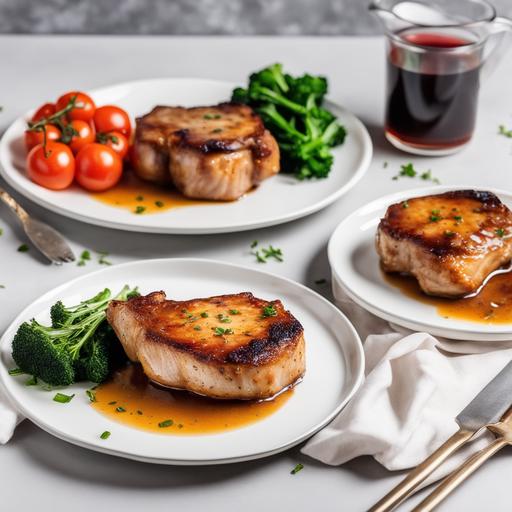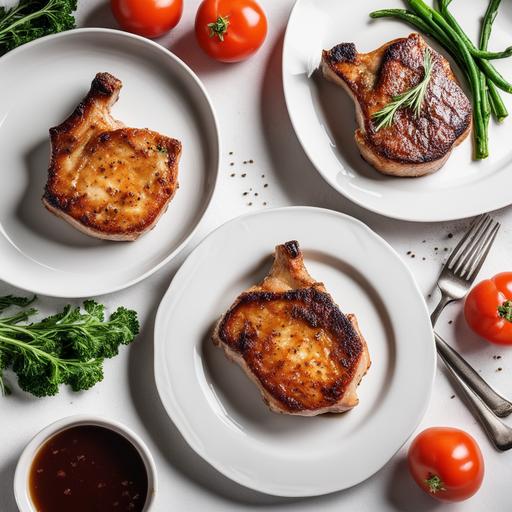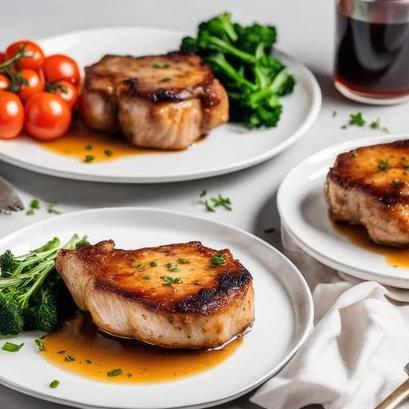
Pork Chops Oven Recipe: A Comprehensive Guide
Pork chops are a delicious and affordable protein source that you can make in a variety of ways. A favorite cooking method for pork chops is oven-roasting, which offers a low-maintenance approach to cooking, and produces succulent, flavorful pork chops with minimal effort. This article explores the many facets of cooking pork chops in the oven, from the science behind the cooking process to recipe variations to troubleshooting common issues.
The Science of Cooking Pork Chops in the Oven
Cooking pork chops in the oven demands attention to certain cooking principles to achieve a perfect result. Firstly, it is important to understand the meat’s composition to cook it appropriately. Pork chops, derived from the loin, are a delicate cut of meat that need to be cooked to a safe internal temperature while avoiding overcooking
Pork chops typically require specific cooking procedures that invite evaporation at the beginning stage of cooking while locking in juices during the cooking process. This balance begins by choosing the right thickness of pork chop for roasting; thicker cuts, between 1-2 inches thick, work best at producing a juicy and tasty result. When using smaller cuts, high heat soaking is required to maintain a compressed muscle, which will help the pork chop stay juicy.
While cooking, pork chops release succulent natural juices. It is imperative to keep all these flavors in the chop by sealing it appropriately. This can be done by searing the pork chops in a pan before cooking, which offers a caramelized exterior, and locking in additional flavor to the pork chops. In addition, seasoning the meat with salt, pepper, and other spices helps balance the chop’s juicy flavors, making the chop more flavorful.
The process of cooking pork chops in the oven should occur on a steady heat temperature; exceeding that might lead to an incomplete cook or overcooking the pork chops. The best temperature range for cooking pork chops in the oven is between 350-375°F. With this temperature range, you can estimate a cooking time of 25-30 minutes for the first two chops, adding five to ten minutes for each additional chop, depending on the thickness.
Selecting Pork Chops
Choosing the right cut of pork chops can often be intimidating for individuals new to cooking. Here are some important guidelines to follow when selecting pork chops.
Cuts:
The whole loin section is substantial, so the butchers divide the cuts into smaller portions. Common cuts of pork chops include:
-
Boneless or bone-in pork chops
-
Center-cut pork chops
-
Rib pork chops
-
Loin Chop pork chops
When buying pork chops, consider the area the chops came from, and choose the cut that fits the meal’s preparation. For example, boneless cuts are an excellent choice for faster cooking methods, while bone-in chops provide additional flavor and juiciness.
Color and Texture:
When examining pork chops at the store, they should have a pale pink color. Avoid chops that have dark spots or appear gray, as they won’t cook as well as the lighter colored chops. In addition, you should look for a firm texture as opposed to a limp or flabby one, which indicates pork chops that are past their prime.
Thickness:
An adequately thick pork chop ensures that it retains temperature better, preventing overcooking or undercooking. Pork chops should be at least one inch thick, although 1 1/2 inches or even 2 inches are the perfect thickness for oven roasting.
Preparing Pork Chops

After selecting the right cut, the preparation process is paramount to a good result. Here are some guidelines for preparing pork chops in preparation for oven roasting.
Cleaning:
Clean the pork chops by washing them in cold water and pat dry with a clean kitchen towel or paper towel.
Rubbing:
Before cooking, rub the chops with salt, pepper, and any additional spice blends you prefer, such as paprika, cumin, and coriander, to intensify the flavors.
Searing:
Searing pork chops is a game-changer and helps to achieve a beautiful brown crust that adds texture and flavor. Heat about 2 tablespoons of oil in an oven-safe skillet, and once very hot, place the pork chops in the skillet and cook until browned, usually for about four minutes. Flip the chops, then brown them on the other side for another four minutes.
Recipe

Let’s dive into a simple recipe to cook pork chops in the oven following the preparation guidelines above.
Ingredients:
-
4 bone-in pork chops, about 1 1/2 inches thick
-
2 teaspoons of salt
-
1 teaspoon black pepper
-
2 tablespoon olive oil
-
2 teaspoon garlic powder
-
2 teaspoon paprika
-
2 teaspoon dried oregano
-
2 tablespoon butter
Instructions:
-
Preheat the oven to 375°F and line a baking sheet with parchment paper.
-
Rub the pork chops with salt, pepper, garlic powder, paprika, and dried oregano.
-
Heat 2 tablespoons of olive oil in an ovenproof skillet over medium heat. Once hot, add the pork chops to the skillet and sear them on each side until golden brown, for approximately 4 minutes per side.
-
Add butter to the skillet and transfer it to the preheated oven.
-
Bake the pork chops for 18-22 minutes or until the internal temperature reaches 145°F.
-
Let the pork chops rest for 5 – 7 minutes before serving.
Tips and Tricks

Variations:
Pork chops can be marinated or rubbed with different spices to achieve a unique flavor to each person’s preference. Here are examples of variation:
-
Balsamic Marinated Pork Chop
-
Honey Garlic Pork Chops
-
Mustard Pork Chop
Checking Doneness:
Using a meat thermometer is the best way to check the chops’ doneness. The USDA recommends cooking pork chops until an internal temperature of 145°F is reached, which is another variable for the oven time.
Avoid Overcooking:
Overcooking pork chops in the oven can make them dry and tough. To prevent overcooking, use a meat thermometer, carefully consider pork chop thickness, and adjust oven temperature accordingly.
Avoid Undercooking:
Undercooked pork can contain harmful bacteria and pathogens that can cause illness. To prevent undercooking, ensure the internal temperature of your pork chop reaches at least 145°F, and let them rest for at least 3 minutes before cutting into them.
Conclusion
Oven-roasting is a simple, yet elegant way to cook pork chops. Follow these cooking tips to produce perfectly seasoned, juicy, and tender pork chops with minimal effort. Select the right cuts, prepare the meat, sear all sides to lock in flavors, and roast the chops to achieve the desired internal temperature with an excellent, succulent result. By following these guidelines, you can add flavorful, delicious pork chops to your weekly meal plan.
Sources
FAQS On Pork Chops Oven Recipe
What Temperature Should I Cook Pork Chops In The Oven?
To ensure proper cooking and to avoid drying out the meat, preheat your oven to 375°F (190°C) before placing the pork chops inside.
How Long Should I Bake Pork Chops In The Oven?
The exact cooking time can vary depending on the thickness of your pork chops. As a general guideline, boneless pork chops that are about an inch thick should be baked for approximately 12-15 minutes. For bone-in pork chops, add a few extra minutes to the cooking time.
Should I Marinate The Pork Chops Before Baking Them In The Oven?
While marinating is not necessary, it can add extra flavor and tenderness to your pork chops. If you have the time, consider marinating the pork chops for at least 30 minutes or up to 24 hours in your preferred marinade.
How Do I Know When The Pork Chops Are Fully Cooked?
The safest way to determine if your pork chops are fully cooked is by using a meat thermometer. Insert the thermometer into the thickest part of the chop, ensuring it does not touch the bone. When the internal temperature reaches 145°F (63°C), the pork chops are safe to eat.
Are There Any Additional Steps I Should Take To Ensure Juicy And Tender Pork Chops?
Yes, there are a few extra steps you can take. First, consider brining your pork chops for 1-2 hours before cooking. This involves soaking them in a mixture of salt and water, which helps to enhance their moisture. Additionally, searing the pork chops in a hot skillet for a couple of minutes on each side before transferring them to the oven can help lock in the juices and promote a flavorful crust.



